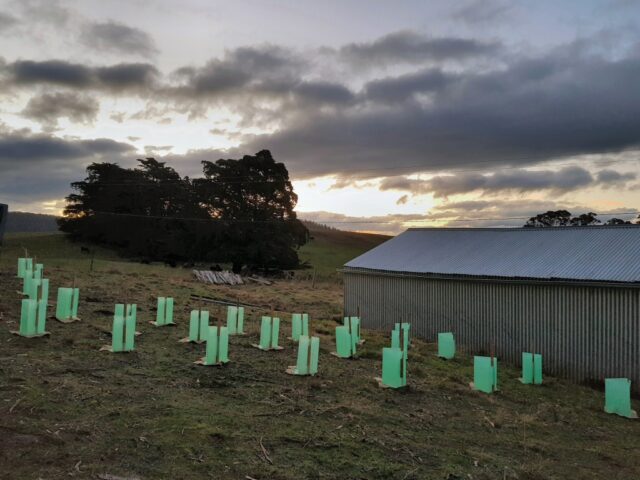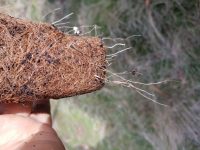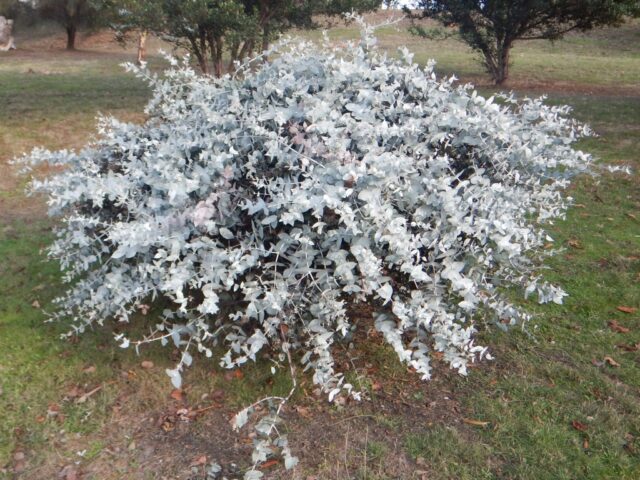Deep (Long Stem) Planting In Action
This month, I want to show you what I think are some inspiring ways to mitigate climate change, whilst also growing beautiful native plants. With the planet in a more critical state than ever, planting trees and shrubs is a fantastically simple way to stabilise soils, store carbon, provide ecosystem services and create beautiful landscapes. This has long been recognised, but often it’s impractical to plant or revegetate an area because of its remoteness from water sources or because of challenging conditions on a site, like exposure to wind and water which can erode and dislodge new plantings.
Deep planting, or longstem tubestock planting, is an innovative method that was developed by Bill Hicks, an Australian electrical engineer with a passion for Australian natives and ecology. I’ve brought Bill’s story to the Gardening Australia program (use the special Gardening Australia search box to find the factsheets on it on their website), and written about this topic on my own website before (https://www.gardeningwithangus.com.au//deep-long-stem-planting-better-plant-establishment-in-the-garden/), where I have given some background there on how Bill developed and applied the technique to ecosystem restoration projects on riverbanks in the Hunter Valley.
Bill Hick’s specific longstem tubestock planting technique is particularly useful for river banks, riparian zones, saline areas, coastal areas and rainforest areas, but it can be tried out anywhere where conditions are difficult for establishing seedlings, such as windy areas or places prone to flooding. The much greater depth of the deep planted root ball allows the plant to withstand much harsher conditions, as it anchors and stabilises the plant and gives the root ball access to stored subsoil moisture.
I want to share how I’ve been using the principles of this innovative technique to start establishing a native arboretum at my farm in Tasmania. I’ll refer to what I’ve been doing as “deep planting” rather than “longstem planting” because it differs a bit from the technique used by Bill Hicks for river ecosystems. Bill used longstem tubestock that had been specially grown to a height of about one metre, and I am using similar principles in my plantings but the plants I am using are not that tall, so I think it’s more apt to describe it as deep planting, because I am simply planting seedlings deeper than normal which still anchors the plant well and helps to protect the root ball from drying out, competition from weeds and being dislodged by wind or rain. The increased depth of planting also encourages adventitious roots to form from the leaf and stem nodes that are underground, which will help the plant get established and survive much better.
The soil at my place in Tasmania is clay-based and quite heavy, and once I have dug to a certain level, it’s almost impossible to dig any deeper, so I’m really interested to see how the deep planting goes in these circumstances. Clay soils retain a lot of water and so I want to see how these conditions affect the root development and establishment of deep-planted seedlings. The general rule for deep planting (depending how long your tubestock is) is the deeper the better, but if you reach the water table, then you’ve gone too far and the plant’s roots may literally drown if planted at that level . The water table will vary with the geology and topography of the land, and at my place the land slopes down to some spring-fed dams, so the water table is obviously quite high at some points, but lower at others. So in some places, I’ll be able to plant quite tall seedlings, but in others it won’t be possible because I’ll reach the water table pretty quickly. I’ll update the progress of my fledgling mini forest in future newsletters. One of the trees I am using is the Risdon peppermint, below…..love the silvery foliage, not to mention the superb oil it produces….
I’ll update the progress of my fledgling mini forest in future newsletters. One of the trees I am using is the Risdon peppermint, below…..love the silvery foliage, not to mention the superb oil it produces….
Fathers Day For Gardening Dads
Fathers Day is on the 1st of September this year….the first day of spring! So what could be better than celebrating with a horticultural bent? Being out in nature is fantastic for physical health and mental wellbeing, so going green is good for dads (and for everybody!). Modern life tends to be going in the opposite way, making it too easy to grab bad food, hop in a car instead of walking, sitting in front of a screen being ‘entertained’. But small changes to these habits can bring good rewards, and I am in the middle of doing exactly that myself! I have dropped 12 kg this year, reversing years of gradual weight gain and it is changing my life.
The following suggestions are great for Dad’s Day, but are also good for anyone we love and care about, which should include ourselves! Giving gifts is good, but this doesn’t have to be in the form of a wrapped present. A gift of your time, maybe for a bushwalk, a trip to the nursery for new plants, a helping hand to create a new garden? How about buying a tree or large shrub, and plant it together as a shared project…..a winner for you and the environment and local wildlife.
Check out my shop for books about gardening with Australian native plants, mastering propagation and growing your own vegies and fruit. If Dad has always wanted to try worm farming and composting, there are products for that too. If you are wanting terrific specialist native plant nurseries, my website has a directory of the best>>>>


